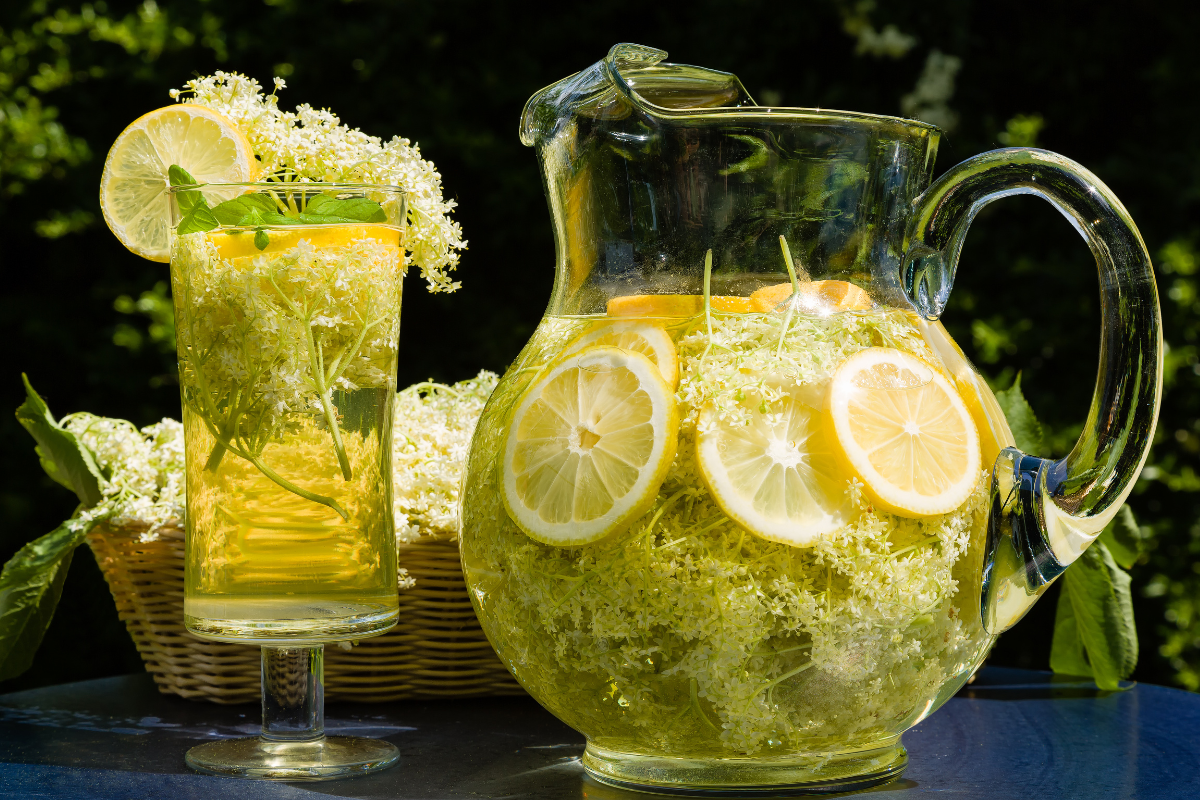How to Make Elderflower Cordial

Nothing signals the start of spring quite like the delicate elderflower! This flower hasn’t just been gracing hedges and farms for millenia - it’s been a kitchen staple for hundreds of years.
In this blog, we're going to show you how to make your own elderflower cordial, a refreshing drink recipe that's perfect for those warm summer days. Mix with carbonated water from your favourite soda machine and enjoy!
So, whether you're a seasoned foodie or just starting to explore the recipe collection of edible flowers, this guide is for you. Let's get started on your march homemade elderflower cordial recipe journey.
What is Elderflower?
Elderflower is a delightful, edible flower that comes from the elder tree. It's a plant that's been around for centuries, and it's known for its distinctive, sweet aroma and delicate, creamy blossoms.

These flowers are not just pretty to look at, they're also packed with flavour. When you make your own elderflower cordial, you're capturing the essence of these blossoms in a bottle. It's a taste that's unique and refreshing, perfect for those warm summer days.
So, if you're looking to try something new and homemade, elderflower could be just the thing. It's a little bit of nature's magic, right in your own kitchen.
Ingredients for Homemade Elderflower Cordial
Creating a homemade elderflower cordial requires a careful selection of ingredients. The quality and freshness of these ingredients play a significant role in the final taste of your cordial. In this section, we will delve into the essential ingredients needed for your homemade elderflower cordial and how to choose the best elderflowers for a flavourful and refreshing drink.
Remember, the key to a great elderflower cordial lies in the balance of flavours. The tartness of lemon and lime, the sweetness of sugar, and the unique aroma of elderflowers all contribute to this delightful beverage.
Essential Ingredients for Your Elderflower Soda Recipe
- 2 unwaxed lemons
- 2 litres of water
- 1 kg of sugar
- 1 tsp of tartaric acid (optional)
- Lemon and lime slices for garnish
- A sprig of mint for garnish
- Sparkling water to serve
- 900g of sugar for a sweeter variant
- 1 litre of water for a less concentrated cordial
- 20 elderflower heads for a stronger flavour
Choosing the Best Elderflowers
Choosing the best elderflowers for your homemade cordial is crucial. The first thing to remember is to pick the flowers early in the morning on a warm and sunny day. This is when they are at their freshest and most aromatic.
Ensure that the flowers are open and not little buds still. The open flowers are the ones that will give your cordial that distinctive elderflower taste.
When picking the flowers, it's best to avoid those below waist level. This is to prevent any contamination from animals that may have urinated on the flowers. So, reach for the very top flowers, if you can.
Once you've picked your elderflowers, lay them out on a table and let them sit for an hour. This allows any little bugs and critters to get off the flowers.
Step-by-Step Guide to Making Elderflower Cordial
This easy homemade recipe is not only fun to make, but it also allows you to enjoy the delightful taste of elderflower in a refreshing drink:
Preparation Process
The first step in our easy homemade recipe for elderflower cordial involves preparing the elderflowers. Here's how you do it:
- Pick the Elderflowers: Start by picking twenty or so heads of fresh elderberry flowers. The more you pick, the stronger the flavour. Make sure the flowers are fully open and not just little buds. The best time to pick them is in the morning on a sunny day.
- Choose the Right Flowers: When picking the flowers, avoid those below waist level. This is to prevent any contamination from animals that may have urinated on the flowers. So, aim for the top flowers if you can.
- Clean the Flowers: Lay the flowers out on a table and let them sit for an hour. This allows any bugs or critters to leave the flowers. After this, gently shake the flowers to dislodge any remaining critters.
- Remove the Flowers from the Stalks: Finally, remove all the flowers from the stalks and place them in a clean bowl. Some people use a fork for this, but I find cutting them off to be easier.
This preparation process is crucial to the success of your homemade elderflower cordial recipe. It ensures that the flowers are clean and ready to infuse their unique flavour into the cordial. Now, you're ready to move on to the cooking and fermentation process.

Cooking and Fermentation
Alright, let's dive into the cooking and fermentation process of our homemade elderflower cordial recipe.
- Start by adding sugar to a large pot.
- Pour in 2 litres of water.
- Bring the mixture to a boil, ensuring all the sugar is dissolved.
- Add slices of lemon and your elderflowers to the hot sugar syrup.
- Let it cook for another ten minutes.
- Now, here's where the magic happens. Allow the flowers and lemon to sit in the water for between 5 and 24 hours. This is the fermentation process, where the natural yeast on the elderflowers interacts with the sugar to create that unique elderflower cordial taste.
This easy homemade recipe is all about patience and letting Mother Nature do her thing. So, don't rush the fermentation process. It's worth the wait!
Storage and Shelf Life
Storing your homemade elderflower cordial is a breeze. Once you've completed the fermentation process, it's time to pop your cordial in the fridge. This is where it will happily sit for the next 3-4 weeks, ready for you to enjoy whenever you fancy a refreshing drink.
But what if you've made a large batch and can't consume it all within a month? No worries! You can also freeze some of your cordial. This way, you can extend its shelf life and have a stash of elderflower cordial ready for those unexpected guests or sudden cravings.
Remember, this cordial recipe doesn't include citric acid, which means it has a shorter shelf life compared to store-bought versions. But the freshness and natural flavours of your homemade elderflower cordial will make up for it.
Serving Elderflower Cordial
If you're a fan of elderflower cordial, you'll love the idea of elderflower soda. This fizzy delight is a refreshing alternative to your regular soft drinks. It's a simple twist on the classic cordial recipe, where you add soda water instead of still water to your elderflower syrup.
The result is a bubbly, sweet, and floral drink that's perfect for hot summer days. It's also a great non-alcoholic option for parties and gatherings.
Remember, you can make your own soda water on demand by subscribing to CO2 YOU. We’ll deliver two or four canisters to your door every month, so you never have to run out.
Like making your own cordial? Try our blackcurrant or blackberry recipe next!
Naturally Fermented Elderflower Cordial
Natural fermentation is a process that's been used for centuries to preserve food and drinks. It's a method that's not only simple but also offers a host of benefits. When it comes to making elderflower cordial, natural fermentation is the secret ingredient that gives it that unique fizz and depth of flavour.
The yeast that naturally coats the elderflower blooms is crucial for the fermentation process. It's this yeast that reacts with the sugar in the recipe, creating carbon dioxide and alcohol. This is what gives your homemade elderflower cordial its delightful fizz.
But the benefits of natural fermentation go beyond just taste. It also helps to preserve the cordial, allowing you to enjoy it for months. Plus, fermented foods and drinks are known to be good for gut health.
So, when you're making your elderflower cordial, don't wash off that natural yeast. It's the key to a naturally fermented elderflower cordial that's not only delicious but also packed with benefits.
How to Naturally Ferment Your Elderflower Cordial
Here's a simple guide to naturally ferment your elderflower cordial.
- Gather your elderflowers: Pick fresh elderflower heads early in the morning on a sunny day. Ensure the flowers are open and not little buds.
- Preparation: Remove the largest stems and keep the flower head clusters. Don't wash them. The yeast that naturally coats the blooms is essential for fermentation.
- Add sugar and water: Fill a jar halfway with sugar and water. Shake well to dissolve the sugar.
- Add lemon juice and elderflowers: Top off the jar with lemon juice and elderflowers. Fill the jar with enough water.
- Cover the jar: Use a piece of cheesecloth or paper towel to cover the jar. Secure it with a jar ring or rubber band.
- Fermentation: Leave the jar at room temperature in a dark place for 2-3 days to ferment.
This method of natural fermentation gives your elderflower cordial a unique, complex flavour. It's a great addition to your recipe collection and a fun March homemade elderflower project to try. Enjoy the taste of naturally fermented elderflower in your food and drinks!
Tips and Tricks for the Perfect Elderflower Cordial
In the quest to make the perfect elderflower cordial, there are a few tips and tricks that can elevate your drink recipe to the next level. From the moment you pick the flower to the final step of the recipe, every detail matters.
Enhancing the Flavour of Your Elderflower Cordial
To enhance the flavour of your elderflower cordial, timing is key. Picking the flowers early in the morning on a sunny day, before it gets too hot, can make a significant difference. The freshest-looking heads, frothy with creamy-white flowers, are the best to pick.
Once you've picked the flowers, give them a good shake to release any insects, then gently rinse them under cool water. Cutting off the stalks is also a good idea as they can add a bitter taste to your cordial.
The goal is to capture the essence of summer in a glass, so don't rush the process. Let the flowers and lemons sit in the syrup for between 5 to 24 hours to fully infuse the flavours.
Common Mistakes to Avoid
- Not picking the flowers at the right time: The best time to pick the flower is early in the morning on a warm and sunny day. This ensures that the flowers are at their freshest and most fragrant.
- Picking flowers from the wrong height: Avoid picking flowers below waist level. Animals may have urinated on these flowers, which can affect the taste of your cordial.
- Not allowing bugs to leave the flowers: After picking, spread the flowers out on a table and let them sit for an hour. This gives any bugs a chance to leave the flowers before you use them in your drink recipe.
- Not removing flowers from the stalks properly: Use a fork or a pair of scissors to remove the flowers from the stalks. This helps to ensure that you only get the best parts of the flower in your cordial.
- Not dissolving all the sugar: When you make a simple syrup for your cordial, ensure all the sugar is fully dissolved before adding the elderflowers and lemon. This will make your cordial sweet and smooth.
Embracing the Versatility of Elderflower in Your Kitchen
The versatility of elderflower in your kitchen is truly remarkable. From a refreshing homemade elderflower cordial to a delightful sprig of mint garnish, the possibilities are endless.
This drink recipe is a testament to the beauty of using nature's bounty in our everyday lives. The process of making your own elderflower cordial is not only rewarding but also a fun culinary adventure.
It's a simple yet satisfying way to bring the taste of spring into your home, regardless of the season.
Remember, you can keep sparkling water on tap all season long with CO2 YOU. Join the refill programme today!


